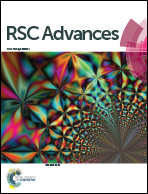Gamma irradiation studies of composite thin films of poly vinyl alcohol and coumarin
Abstract
Composite films of imperatorin (a coumarin molecule) and poly vinyl alcohol (PVA) are prepared by a solution casting method. These composite films are exposed to γ-radiation of different doses at room temperature. These composite films are characterized by X-ray diffraction (XRD), Fourier transform infrared (FT-IR), UV-Visible and dielectric spectroscopy. After doping, the XRD data shows semicrystalline to amorphous phase formation in the PVA back bone. FT-IR analysis of these composite films shows various bands and a significant impact on them can be observed after irradiation. UV-Visible spectroscopy of these composite films shows various absorption bands. But the absorption band at 311 nm is the sharpest one. In these films, the optical band gap is determined by using Tauc's plots. These films follow indirect allowed transitions. In the present samples, the optical band gap increases with irradiation and finally decreases at the highest dose. The Urbach energy also decreases with increasing radiation dose, and gives clear indication that radiation induced defects are formed in the system. Additionally, both the dielectric constant and loss change with radiation dose. These changes are explained based on a universal dielectric response (UDR) model which also supports disorder in the system.


 Please wait while we load your content...
Please wait while we load your content...